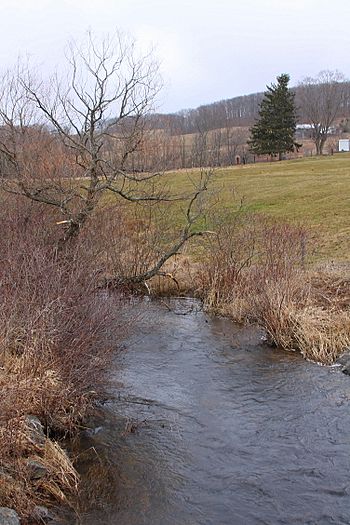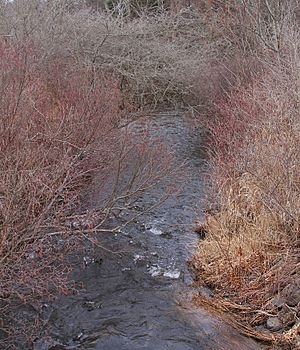Rogers Creek (Pennsylvania) facts for kids
Quick facts for kids Rogers Creek |
|
|---|---|

Rogers Creek looking upstream
|
|
| Other name(s) | Marsh Creek |
| Physical characteristics | |
| Main source | confluence of Marsh Creek and Black Ash Creek in Ross Township, Luzerne County, Pennsylvania between 960 and 980 feet (290 and 300 m) |
| River mouth | Huntington Creek in Huntington Township, Luzerne County, Pennsylvania 764 ft (233 m) 41°11′32″N 76°14′09″W / 41.1921°N 76.2357°W |
| Length | 2.9 mi (4.7 km) |
| Basin features | |
| Progression | Huntington Creek → Fishing Creek → Susquehanna River → Chesapeake Bay |
| Basin size | 7.10 sq mi (18.4 km2) |
| Tributaries |
|
Rogers Creek is a small stream in Luzerne County, Pennsylvania, USA. It's also sometimes called Marsh Creek. This creek is a tributary (a smaller stream that flows into a larger one) of Huntington Creek.
Rogers Creek is about 2.9 miles (4.7 km) long. It flows through two areas: Ross Township and Huntington Township. The land area that drains into the creek, called its watershed, covers about 7.10 square miles (18.4 km2).
This creek is special because it's a great place for fish. It's known as a Coldwater Fishery and a Migratory Fishery. This means it has cool water that fish like, and it's a path for fish that travel to different places. The creek flows through wide valleys in some spots and narrow, rocky areas called gorges in others. Long ago, in the late 1700s, people built mills along its banks.
Contents
Where Rogers Creek Flows
Rogers Creek starts where two smaller streams, Marsh Creek and Black Ash Creek, meet in Ross Township. From there, it flows south-southwest for a short distance. It quickly enters Huntington Township.
The creek then turns west for a bit before heading south. After that, it gently curves south-southwest for several tenths of a mile. Finally, it turns south again and meets Huntington Creek at a place called Huntington Mills.
Rogers Creek joins Huntington Creek about 12.90 miles (20.76 km) before Huntington Creek reaches its own end.
Smaller Streams Joining Rogers Creek
Rogers Creek has two main smaller streams that flow into it. These are Marsh Creek and Black Ash Creek.
- Marsh Creek: This stream joins Rogers Creek about 2.82 miles (4.54 km) upstream from where Rogers Creek ends. The area that drains into Marsh Creek is about 4.04 square miles (10.5 km2).
- Black Ash Creek: This stream also joins Rogers Creek about 2.82 miles (4.54 km) upstream from its mouth. The land area that drains into Black Ash Creek is about 1.46 square miles (3.8 km2).
Land and Rocks Around the Creek
The land near where Rogers Creek meets Huntington Creek is about 764 feet (233 m) above sea level. Where Rogers Creek begins, its elevation is higher, between 960 and 980 feet (290 and 300 m) above sea level.
For part of its journey, Rogers Creek flows through a wide valley. Underneath this valley are deposits left behind by ancient glaciers. Further downstream, the creek cuts through a narrow, rocky gorge. You can even find several waterfalls in this section!
Long, long ago, before the glaciers, Rogers Creek probably flowed through a different path. It might have gone through a low spot (called a saddle) about 0.5 miles (0.80 km) north of its current gorge. Today, that saddle is filled with glacial deposits, and a road now runs where the old path used to be.
The ground along Rogers Creek is mostly made of alluvium (soil deposited by water) and solid bedrock. This bedrock is made of sandstone and shale. In most of the rest of the creek's watershed, the ground has a type of till (rock and soil left by glaciers) called Wisconsinan Till. There are also some wetlands in the area.
The Creek's History
Rogers Creek was officially added to the Geographic Names Information System (a database of place names) on August 2, 1979. Its special ID number in this system is 1185391.
As mentioned, the creek is also known as Marsh Creek. You can see this name on maps published by the Pennsylvania Department of Transportation.
The very first gristmill (a mill for grinding grain) in Huntington Township was built at the mouth of Rogers Creek in 1788 by a person named Mr. Hopkins. He also built a sawmill there. Later, in 1798, Nathan Beach built another mill called the Rogers Mill on the creek. In the early 1900s, local officials asked for permission to build a bridge over the creek.
Animals and Nature
The entire area that drains into Rogers Creek is a special place for fish. It's officially called a Coldwater Fishery and a Migratory Fishery.
- Coldwater Fishery: This means the water stays cool enough for fish that need cold temperatures to live.
- Migratory Fishery: This means it's a route for fish that travel, or migrate, between different places.
Wild trout naturally live and reproduce in Rogers Creek. You can find them from where the creek starts all the way to where it joins Huntington Creek. Trout also reproduce in Marsh Creek, one of Rogers Creek's tributaries.


